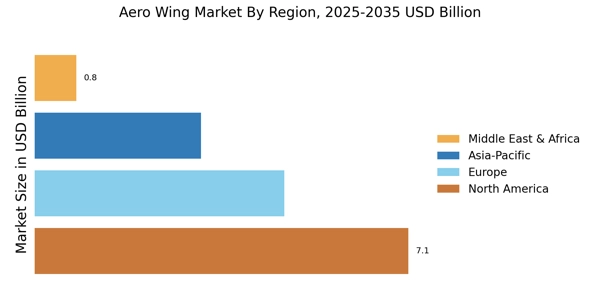Rising Demand for Fuel Efficiency
The Aero Wing Market is experiencing a notable increase in demand for fuel-efficient aircraft designs. Airlines are increasingly prioritizing fuel economy to reduce operational costs and meet regulatory requirements. According to recent data, aircraft equipped with advanced aero wings can achieve fuel savings of up to 15% compared to traditional designs. This trend is driven by the need for airlines to enhance profitability while minimizing their environmental footprint. As a result, manufacturers are investing in research and development to create innovative wing designs that optimize aerodynamics and reduce drag. The emphasis on fuel efficiency is likely to shape the future of the Aero Wing Market, as stakeholders seek to balance performance with sustainability.
Growth of the Commercial Aviation Sector
The Aero Wing Market is poised for growth, driven by the expansion of the commercial aviation sector. As air travel demand continues to rise, airlines are investing in new aircraft to accommodate increasing passenger numbers. This trend is reflected in the projected increase in aircraft deliveries, with estimates suggesting a need for over 39,000 new aircraft by 2038. Consequently, the demand for advanced aero wings that enhance performance and efficiency is likely to surge. Manufacturers are responding to this growth by developing innovative wing designs that cater to the evolving needs of airlines. The expansion of the commercial aviation sector is expected to be a key driver for the Aero Wing Market in the foreseeable future.
Emergence of Electric and Hybrid Aircraft
The Aero Wing Market is witnessing a transformative shift with the emergence of electric and hybrid aircraft. As the aviation sector seeks to reduce its carbon footprint, manufacturers are exploring new wing designs that accommodate electric propulsion systems. These aircraft require specialized aero wings to optimize performance and efficiency. The market for electric and hybrid aircraft is projected to grow significantly, with estimates indicating a potential market size of over 1.5 billion USD by 2030. This shift presents opportunities for innovation within the Aero Wing Market, as companies develop wings that support the unique requirements of these new aircraft types. The rise of electric and hybrid aviation is likely to redefine the competitive landscape and drive technological advancements.
Technological Innovations in Aerodynamics
Technological advancements in aerodynamics are significantly influencing the Aero Wing Market. Innovations such as computational fluid dynamics (CFD) and wind tunnel testing have enabled engineers to design wings that maximize lift and minimize drag. These technologies facilitate the development of new wing shapes and configurations that enhance aircraft performance. For instance, the introduction of winglets has been shown to improve fuel efficiency by reducing vortex drag. The Aero Wing Market is likely to benefit from these advancements, as they not only improve aircraft performance but also contribute to lower emissions. As competition intensifies, manufacturers are compelled to adopt cutting-edge aerodynamic technologies to remain relevant in the market.
Regulatory Pressures for Emission Reductions
The Aero Wing Market is increasingly influenced by regulatory pressures aimed at reducing aviation emissions. Governments and international organizations are implementing stricter emission standards, compelling manufacturers to innovate and develop more environmentally friendly aircraft. The International Civil Aviation Organization (ICAO) has set ambitious targets for carbon neutral growth, which necessitates advancements in wing design to enhance fuel efficiency and reduce emissions. This regulatory landscape is driving investment in research and development within the Aero Wing Market, as companies strive to comply with evolving standards while maintaining competitive advantages. The focus on emissions reduction is expected to shape product offerings and influence market dynamics in the coming years.


















Leave a Comment